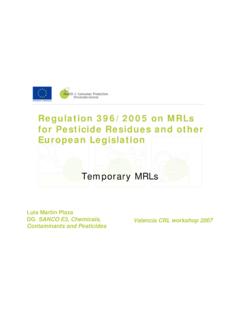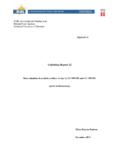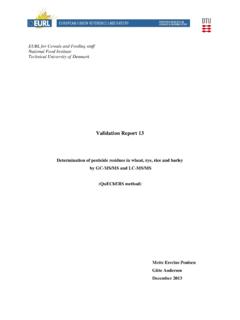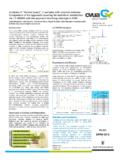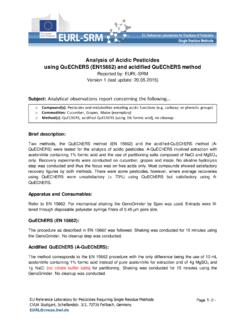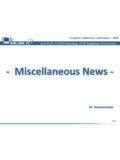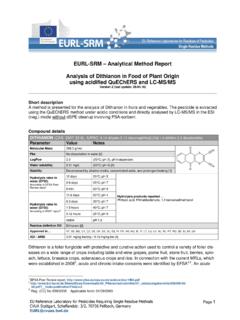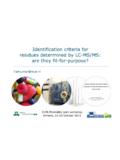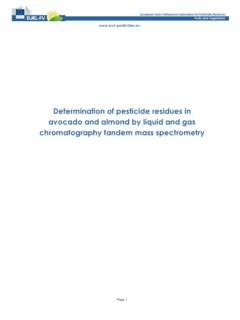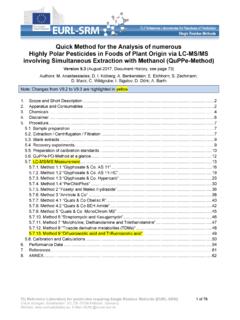Transcription of Main changes introduced in Document ... - EURL | …
1 Main changes introduced in Document N SANTE/2015/11945 with respect to the previous version ( Document N SANCO/ 2013 / 12571 ) 1) Amendments which are concerned with editorial improvements throughout the Document . Moreover a review of terminology throughout the Document regarding the definition of sample preparation and processing has been made. 2) Old paragraph C44 has been moved to paragraph G5 Analytical method validation and performance criteria for better matching of the content. 3) Old Table 1 of Appendix A, Validation parameters and criteria has been moved from Appendix A to paragraph G Analytical method validation and performance criteria . 4) D2: The tolerance criteria for retention time has been changed from to 5) Old D1-D14 paragraphs (new D1-D15) have been rewritten highlighting the difficulties of identification criteria based on MS spectra as well as new paragraphs for clarification purposes on the requirements for identification using selected ions.
2 6) Old Tables 4 and 5 have been merged into one (new Table 4). 7) E1 Expression of results: The paragraphs have been amended regarding the reporting of results from the individual analytes for cases where the residue definition includes more than one analyte. A new sentence has been added concerning the electronic submission of results from monitoring programmes, where the LOQs for all individual analytes must be submitted 8) Old E5 paragraph (new E3) Calculation of results: The text has been rewritten for clarification. Further clarification on how to calculate the results when only two replicate analyses have been performed has been added. 9) F8-F11. Testing and replacement of standards: The new text has been amended to clarify the tolerances for the new standards. 10) Annex A: Addition of Feed as representative matrices.
3 11) Appendix A: The text and paragraphs have been reorganised and an initial validation plan for quantitative methods has been introduced . 12) Old Appendix D: Guidance for EFSA has been deleted from the procedures. 13) Old Appendix E. Glossary (new Appendix D): The text has been modified regarding the matrix effect and matrix calibration, as well definitions and terms which have been modified in the body of the text. ANALYTICAL QUALITY CONTROL AND METHOD VALIDATION PROCEDURES FOR PESTICIDE RESIDUES ANALYSIS IN FOOD AND FEED Supersedes Document No. SANCO/ 12571 / 2013 . Implemented by 01/01/2016 Coordinators: Tuija Pihlstr m NFA, Uppsala, Sweden Amadeo R. Fern ndez-Alba EURL-FV, University of Almer a, Almer a, Spain Miguel Gam n EURL-FV, Generalitat Valenciana, Valencia, Spain Mette Erecius Poulsen EURL-CF, DTU National Food Institute, Soeborg, Denmark Ralf Lippold EURL-AO, CVUA Freiburg, Freiburg, Germany Michelangelo Anastassiades EURL-SRM, CVUA Stuttgart, Fellbach, Germany Advisory Board.
4 Stewart Reynolds Fera, York, United Kingdom Andr de Kok NVWA, Wageningen, The Netherlands Darinka Stajnbaher Institute of Public Health, Maribor, Slovenia Finbarr O Regan Pesticide Control Laboratory, DAFM, Kildare, Ireland Philippe Gros Service Commun des Laboratoires, Montpellier, France Carmen Ferrer Amate EURL-FV, University of Almer a, Almer a, Spain Antonio Valverde University of Almer a, Almer a, Spain Sonja Masselter AGES, Institute for Food Safety, Innsbruck, Austria Hans Mol RIKILT - Wageningen UR, Wageningen, The Netherlands Magnus Jezussek LGL, Erlangen, Germany Octavio Malato EURL-FV, University of Almer a, Almer a, Spain CONTENT MIRAR TABULACION DEL INDICE Y DEL RESTO A. Introduction and legal background _____ 1 B. Sampling, transport, traceability and storage of laboratory samples _____ 2 Sampling _____ 2 Transport _____ 2 Traceability _____ 2 Storage _____ 2 C.
5 Sample analysis _____ 3 Sample preparation and processing _____ 3 Pooling of samples _____ 3 Extraction _____ 4 Extraction conditions and efficiency _____ 4 Clean-up, concentration/reconstitution and storage of extracts _____ 4 Chromatographic separation and determination _____ 4 Calibration for quantification _____ 5 General requirements_____ 5 Representative analytes for calibration _____ 6 Matrix-matched calibration _____ 6 Standard addition _____ 7 Effects of pesticide mixtures on calibration _____ 7 Calibration for pesticides that are mixtures of isomers _____ 7 Procedural Standard Calibration _____ 7 Calibration using derivative standards or degradation products _____ 8 Use of various internal standards _____ 8 Data processing _____ 9 On-going method performance verification during routine analysis _____ 9 Quantitative methods _____ 9 Routine recovery check _____ 9 Acceptance criteria for routine recoveries _____ 10 Screening methods _____ 10 Proficiency testing _____ 10 D.
6 Identification of analytes and confirmation of results _____ 11 Identification _____ 11 Mass spectrometry coupled to chromatography _____ 11 Requirements for chromatography _____ 11 Requirements for mass spectrometry (MS) _____ 11 Recommendations regarding identification using MS spectra _____ 11 Requirements for identification using selected ions _____ 11 Confirmation of results _____ 13 E. Reporting results _____ 14 Expression of results _____ 14 Calculation of results _____ 14 Rounding of data _____ 14 Qualifying results with measurement uncertainty _____ 15 Interpretation of results for enforcement purposes _____ 15 F. Pesticide standards, stock solutions and calibration standard solutions _____ 17 Identity, purity, and storage of reference standards _____ 17 Preparation and storage of stock standards _____ 17 Preparation, use and storage of working standards _____ 18 Testing and replacement of standards _____ 18 G.
7 Analytical method validation and performance criteria _____ 19 Quantitative methods _____ 19 Method performance acceptability criteria _____ 19 Screening methods _____ 20 Method performance acceptability criteria _____ 21 H. Additional recommendations _____ 22 Contamination _____ 22 Interference _____ 22 Annex A Commodity groups and representative commodities _____ 23 Appendix A. Method validation procedure: outline and example approaches _____ 26 Appendix B. Examples of conversion factors. _____ 29 Appendix C. Examples for the estimation of measurement uncertainty of results _____ 31 Appendix D. Glossary _____ 34 Page 1 of 42 ANALYTICAL QUALITY CONTROL AND METHOD VALIDATION PROCEDURES FOR PESTICIDE RESIDUES ANALYSIS IN FOOD AND FEED A. Introduction and legal background A1 The guidance in this Document is intended for laboratories involved in the official control of pesticide residues in food and feed across the European Union.
8 This Document describes the method validation and analytical quality control (AQC) requirements to support the validity of data reported within the framework of official controls on pesticide residues and used for checking compliance with maximum residue levels (MRLs), enforcement actions, or assessment of consumer exposure. The key objectives are: to provide a harmonized, cost-effective quality assurance and quality control system across the EU to ensure the quality and comparability of analytical results to ensure that acceptable accuracy is achieved to ensure that false positives or false negatives are avoided to support compliance with, and specific implementation of ISO/IEC 17025 (accreditation standard) A2 This Document is complementary and integral to the requirements in ISO/IEC 17025.
9 A3 The glossary (Appendix D) should be consulted for definitions and explanation of terms used in the text. In accordance with Article 12 of Regulation (EC) No. 882/2004, laboratories designated for official control of pesticide residues must be accredited to ISO/IEC 17025. According to Article 11 of Regulation (EC) No. 882/2004, analytical methods used in the context of official controls shall comply with relevant European Union rules or with internationally recognised rules or protocols or, in the absence of the above, with other methods fit for the intended purpose or developed in accordance with scientific protocols. Where the above does not apply, validation of analytical methods may further take place within a single laboratory according to an internationally accepted protocol. According to Article 28 of Regulation (EC) No.
10 396/2005, technical guidelines dealing with the specific validation criteria and quality control procedures in relation to analytical methods for the determination of pesticide residues may be adopted in accordance with the procedure referred to in Article 45(2) of this regulation. The present Document includes mutually acceptable scientific rules for official pesticide residue analysis within the EU as agreed by all Member States of the European Union and constitutes a technical guideline in the sense of article 28 of Regulation (EC) No. 396/2005. It should thus be consulted during audits and accreditations of official pesticide residue laboratories according to ISO/IEC 17025. Page 2 of 42 B. Sampling, transport, traceability and storage of laboratory samples Sampling B1 Food samples should be taken in accordance with Directive 2002/63/EC or superseding legislation.
